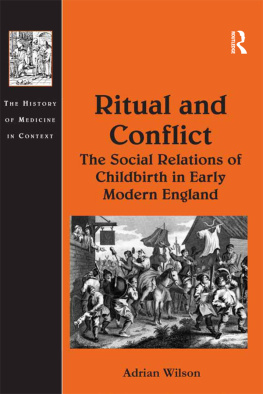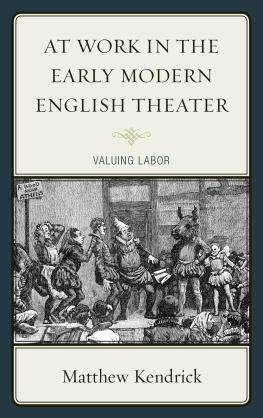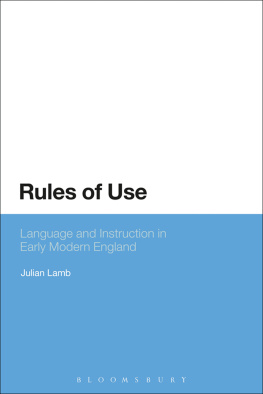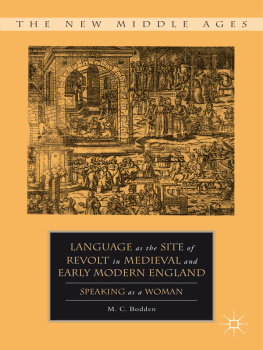Censorship and Cultural Sensibility
Censorship and Cultural Sensibility
The Regulation of Language in Tudor-Stuart England
Debora Shuger

Copyright2006 University of Pennsylvania Press
All rights reserved
Printed in the United States of America on acid-free paper
10 9 8 7 6 5 4 3 2 1
Published by
University of Pennsylvania Press
Philadelphia, Pennsylvania 19104-4112
Excerpts from the essay Civility and Censorship in Early Modern England by Debora Shuger, originally published in Censorship and Silencing Practices of Cultural Regulation, ed. Robert C. Post, reprinted, with changes, by permission of the publisher.1998 by the Getty Research Institute (formerly the Getty Research Institute for the History of Art and the Humanities, Los Angeles, CA).
Library of Congress Cataloging-in-Publication Data
Shuger, Debora K., 1953
Censorship and cultural sensibility: the regulation of language in Tudor-Stuart England / Debora Shuger.
p. cm.
Includes bibliographical references and index.
ISBN-13:978-0-8122-3917-1
ISBN-10:0-8122-3917-2 (cloth : alk. paper)
1. Freedom of the pressEnglandHistory16th century. 2. Freedom of the pressEnglandHistory17th century. 3. Politeness (Linguistics)EnglandHistory16th century. 4. Politeness (Linguistics)EnglandHistory17th century. I. Title.
KD4112.S55 2005
342.4208'53dc22
2005042376
For Russ
Contents
Introduction
We must cease once and for all to describe the effects of power in negative terms: it excludes it represses it censors
Foucault, Discipline and Punish
In his famously provocative essay on the licensing of books in Tudor-Stuart England, Christopher Hill noted that Miltons Areopagitica, first published in 1644, was among the many principled defenses of freedom of the press from pre-publication censorship.
Censorship and English Literature, the essay from which Hills remark about the many principled defenses of a free press in early modern England comes, depicted Tudor-Stuart censorship as a repressive instrument of
This new scholarship bears the marks of the revisionist historiography of the post-Cold War era, with its picture of discrete and shifting sites of localized tensionsas opposed to the temporal unfolding of fundamental ideological conflict. As such, it has simultaneously opened and barred a large window of scholarly opportunity. If Tudor-Stuart censorship was not a drawn-out attempt to silence dissent, but a pragmatic situational response to an extraordinary variety of particular events, then it made sense to look carefully at each case to ferret out its particular context and causes. Although the remark does not explicitly say that the accusations pertained to the play, this seems the obvious inference, and one made by virtually all Jonson scholars. Yet Sejanus depicts the imperial court under Tiberius. It makes no overt reference to popery, nor can it be read as an allegory of papal Rome. Its portrayal of the emperor is sufficiently negative to make the treason charge comprehensible, but on what basis might anyone have thought that the play upholds popery?
In truth, I think that I have a fairly good idea as to why the authorities responded to these works as they did. My explanations, however, are guesswork: informed guesses perhaps, but still based on no more than intuitions and assumptions, both of which I have come to distrust, since on those occasions when I have come across a cache of evidence regarding a particular censorship incident, the reasons defied expectation.
Much of the new work on early modern censorship, for all its careful contextualization, finally rests on conjecture, some of it plausible, some of it preposterousnor is there any way around this, unless, of course, one discovers material containing the actual reasons something was or was not allowed into print. When that happens, the results can be spectacular. Thus, thanks to Peter Lakes dazzling research, we now know why in 1632 the High Commission, with its panel of Laudian clerical judges, imprisoned a self-taught London artisan for a book published with license and without incident fifteen years earlier. Yet this remains one of the very few successful attempts to reconstruct the local contingencies behind a specific act of censorship. Most of the time, too many pieces of the puzzle have been lost for one to determine with any reliability what the original picture looked like.
If Hills insistence upon the programmatic top-down character of Recent studies view Tudor-Stuart censorship as less constraining than Hill had done, but the poles of authorial freedom and state repression remain the salient criteria.
That these are our categories, not early modern ones, would be denied by no one, yet neither is it the caseas is sometimes assumedthat the early modern position, or at least the official one, merely inverts our own values, preferring dogmatism over tolerance, hierarchy over equality, obedience over transgression, orthodoxy over inquiry, containment over subversion, state over individual. In general, Tudor-Stuart persons, authorities and authors alike, did not conceive of censorship in these terms. It is, however, hard for us to think in any other terms, particularly about censorship. They are already in place by the mid-eighteenth century. The first chapter of the first book of Blackstones Commentaries is entitled The Rights of Persons, with subsections on absolute rights, civil liberty, liberty of conscience, personal liberty, taxation and representation, the right to bear arms, and right of private property.fundamentally different way of thinking about what people may and may not do with words.
The overarching project of this book is thus to recover the system of beliefs and values that made the regulation of language, including state censorship, seem a good ideathat made such regulation seem no less obviously right and necessary than constraints on nonverbal behavior. The sharp separation of the two is a distinguishing feature of modern, and particularly American, jurisprudence, in contrast to earlier law, which tended to take words as seriously as sticks or stones. The regulation of words, of language, was, in fact, a central project of the mid-sixteenth to mid-seventeenth centuries, the period with which this book is primarily concerned. In England, both the mechanisms of press censorship and much of the temporal law, civil as well as criminal, pertaining to transgressive words date from this period. On the Continent, the first papal bull dealing with censorship issues was promulgated in 1515, Leo Xs Inter sollicitudines; the first papal index of forbidden books in 1559. The papal censorship office, the Congregation of the Index, came into being in 1571. This pan-European attention to the problem of transgressive language responded to the emergent realities of print and Protestantism. Yet the English laws regulating language have very little in common with the papal ones.
Both the papal and Tudor-Stuart laws draw on bodies of jurisprudence going back to antiquity. The English laws, as was known at the time, have their roots in Roman laws of the fifth century B.C.laws that became the basis for two important sections of Justinians sixth-century A.D. codification of Roman law, the








